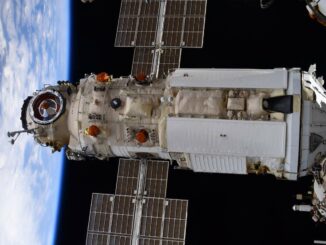
The 900-ton suspended platform of Puerto Rico’s famed Arecibo Observatory collapsed Tuesday after cable failures, crashing into the radio telescope’s iconic dish and shattering a research instrument used for nearly 60 years to study pulsars, galaxies, planets, and asteroids that might threaten Earth.
The National Science Foundation, which owns the facility, confirmed the instrument deck fell around 7:55 a.m. local time Tuesday in Puerto Rico, “resulting in damage to the dish and surrounding facilities.”
No injuries were reported in the accident.
The NSF announced last month that it would decommission and demolish the observatory after a series of cable breaks rendered the facility unsafe. The first suspension cable snapped Aug. 10, causing a gash in the observatory’s 1,000-foot (305-meter) reflecting dish.
While officials assessed repair options, another cable broke Nov. 6. Inspections and analyses showed other cables were in danger of failing, and the NSF announced Nov. 19 that engineers recommended a controlled demolition of the structure, which officials said then was in danger of a collapse on its own in the near future.
The collapse happened Tuesday before crews could start the demolition. The failure shattered sensitive radio receivers and a planetary radar instrument as the platform fell onto the dish some 450 feet (137 meters) below.
Completed in 1963, the observatory was the second-largest radio telescope in the world and featured in films like “Contact” and “GoldenEye.” The giant dish reflected faint radio signals from deep space onto sensors suspended on the instrument platform.
Muy tristes las fotos desde el Observatorio de Arecibo. pic.twitter.com/7gByZLdPFF
— Deborah Martorell (@DeborahTiempo) December 1, 2020
“We are saddened by this situation but thankful that no one was hurt,” said Sethuraman Panchanathan, NSF’s director, in a statement. “When engineers advised NSF that the structure was unstable and presented a danger to work teams and Arecibo staff, we took their warnings seriously and continued to emphasize the importance of safety for everyone involved.
“Our focus is now on assessing the damage, finding ways to restore operations at other parts of the observatory, and working to continue supporting the scientific community, and the people of Puerto Rico,” Panchanathan said.
“Initial findings indicate that the top section of all three of the 305-meter telescope’s support towers broke off. As the 900-ton instrument platform fell, the telescope’s support cables also dropped,” the NSF said in a statement.
Officials said the observatory’s learning center also “sustained significant damage” from the falling cables.
Saddened by the collapse, astronomers shared memories of their work at Arecibo on social media. Some scientists called on the observatory to be rebuilt.
The National Science Foundation just released videos of the collapse of Arecibo Observatory in Puerto Rico on Tuesday.
📷: @NSF
Earlier story: https://t.co/sHpHwY9PQH pic.twitter.com/CeXnC9oSV5
— Spaceflight Now (@SpaceflightNow) December 3, 2020
“Many scientists have worked on this telescope over the last 50-plus years,” said Thomas Zurbuchen, head of NASA’s science directorate. “Those observations have provided tremendous insights in some of the most energetic parts of our universe, pulsars. They have provided important planetary science looking at the moon and Mars … And also they have contributed tremendously to planetary defense objectives.”
With a planetary radar, Arecibo Observatory allowed scientists to characterize the shape, make-up, and orbits of asteroids on trajectories that intersect Earth’s orbit.

“Our hearts are heavy about this,” Zurbuchen said Tuesday in a meeting of the NASA Advisory Council’s Science Committee.
Lindley Johnson, NASA’s planetary defense officer, said the loss of the Arecibo Observatory will not affect scientists’ ability to detect asteroids that might be on a collision course with Earth.
NASA has a radar imager at its Goldstone tracking station in California that can see a wider swath of the sky with finer resolution than Arecibo.
“But Arecibo had the range, so some of the planetary science at more distant objects will probably suffer the greatest impact,” J0hnson said Monday, before the observatory’s collapse. “We will no longer have the range that Arecibo offered.
“It’s really time to be looking at the next generation of planetary radar capabilities,” Johnson said. “Large dish radio telescopes is probably not the way to go with modern capabilities and processing. An array dish approach is probably the way.”

With its high-power transmitter, Arecibo’s radar could study objects in the asteroid belt and deeper into the solar system.
“It all comes down to power, really,” Johnson said. “Arecibo had the higher-power transmitter than Goldstone does, so the opportunities may not be as great with just Goldstone.”
Goldstone’s antenna is also used to communicate with deep space probes, so any scientific radar observations must be scheduled around spacecraft requirements, Johnson said.
The Arecibo Observatory is managed by the University of Central Florida. The NSF said it will continue to authorize UCF to pay Arecibo staff and continue research work at Arecibo, including the repair of a smaller telescope for radio astronomy research and other infrastructure repairs to address damage from Hurricane Maria in 2017.
“We knew this was a possibility, but it is still heartbreaking to see,” said Elizabeth Klonoff, UCF’s vice president for research. “Safety of personnel is our number one priority. We already have engineers on site to help assess the damage and determine the stability and safety of the remaining structure. We will continue to work with the NSF and other stakeholders to find ways to support the science mission at Arecibo.”
Email the author.
Follow Stephen Clark on Twitter: @StephenClark1.



